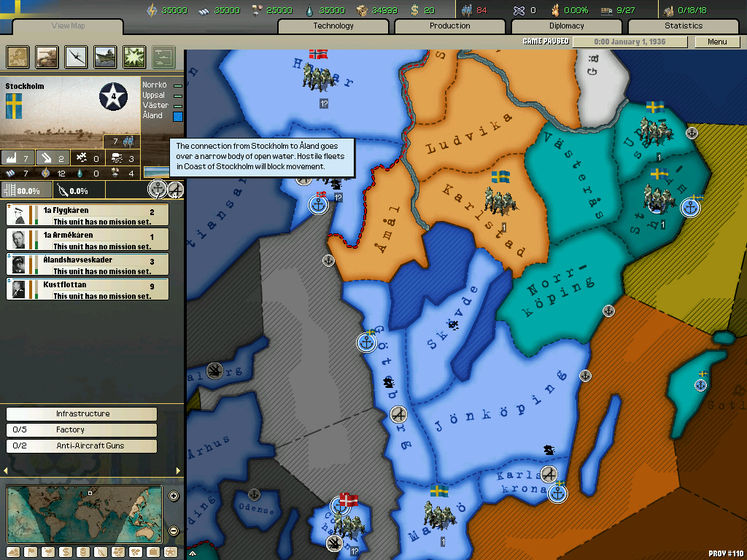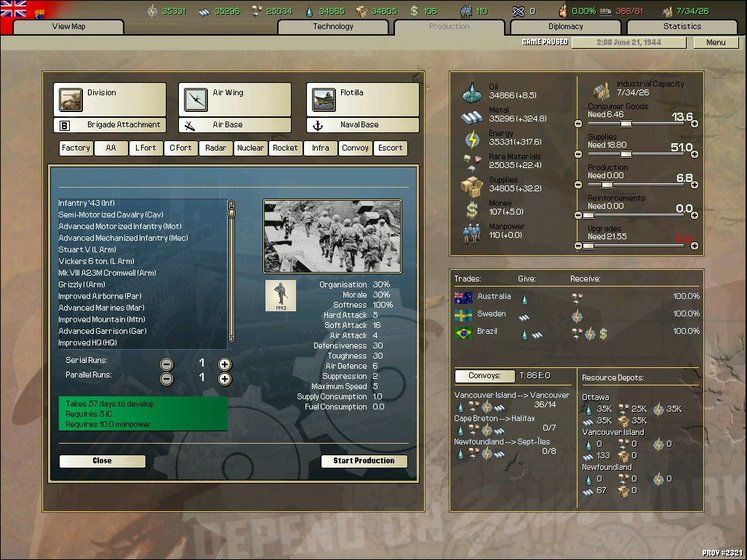The sequel to Hearts of Iron, Paradox's World War 2 grand strategy title, seems to remedy most of the mistakes of its predecessor, which was mostly a variation of the Europa Universalis engine, its complexity being one of the major downsides of the game. While in the first Hearts of Iron events didn’t always turn out historically, you could always have some of the more hostile factions applying political pressure on more feeble countries, like Germany tending to influence Austria more and more.
Hearts of Iron 2 seems to have learned a bit from its predecessor’s errors, now scenarios being much more open-ended than before, though some scripted actions will take place. Paradox has also been able to fix most off the issues that were a problem in the first Hearts of Iron, getting rid of the massive armies and the un-friendly interface for reinforcing/upgrading forces.
Various additional issues have been fixed as well. Aircrafts no longer keep flying missions repeatedly waiting to be told to halt by a player. Now they have a timer which the player can set for beginning and ending an action, whether they have to fly missions in daylight or not (or both) or at what strength level. Therefore, now you can command your bombers to attack an armored division only for 5 days, only at night and only if they have at least a certain percentage of their combat strength. Air fleets will have limited mobility. They will only be able to station in pre-built air stations. Of course, the player can build new ones, but this takes up quite a long time.
Planning things in advance is one of the most important things to keep in mind when playing Hearts of Iron 2. Careers take more than a year to develop so gathering enough resources and labor for the next-generation career can prove an easier task than choosing what it would be. Researching new military doctrines and technologies can give you a precious advantage over the opposing force. Playing a diplomatic game with other nations will help you gain resources or assistance when needed. Every decision, even though it would seem small in the beginning, can affect how things develop after a certain period of time.
In order to make gameplay decisions easier, the research tree has been streamlined with regards to many aspects. Now there are nine categories to research, which overlap each other a lot less than in the first Hearts of Iron. The player won’t have to research every aspect of certain technology, like prototypes, armament development and so on, thus giving less detail and turning off the most of the veteran hard core gamers, but also making the game easier to cope with for the non veteran players. Paradox has chosen to make trade politics and diplomacy far less rigid as well.
The amount of provinces has been dramatically increased, as can be seen when looking at the map, parting forces even further but making encirclements a little more likely happen - especially in the large open steppes of Russia.
Paradox will ship the game with a various number of scenarios that vary in size, with objectives ranging from trying to obtain key objectives to earning the most victory points. The clock will always run forward in Hearts of Iron 2, as the action takes place in continuous time, but the player can always slow things down if needed - when having to deal with a more difficult period, when issuing orders and making research decisions etc. Paradox is trying to improve the gameplay by applying a more streamlined interface to Hearts of Iron 2. Also they seem to have cosmetically improved certain graphical aspects, like, for instance a more detailed map of the regions. But most of the symbols that Hearts of Iron players are familiar with haven’t been changed, like the ones for aircraft carriers and for infantry divisions.
Shipping early next year, Hearts of Iron 2 still has to make some improvements, but it is most likely to bring satisfaction to hardcore strategy gamers, and with a bit of luck, could make other gamers take a peek at it too. We look forward to seeing Hearts of Iron 2 on the shelves next year.







